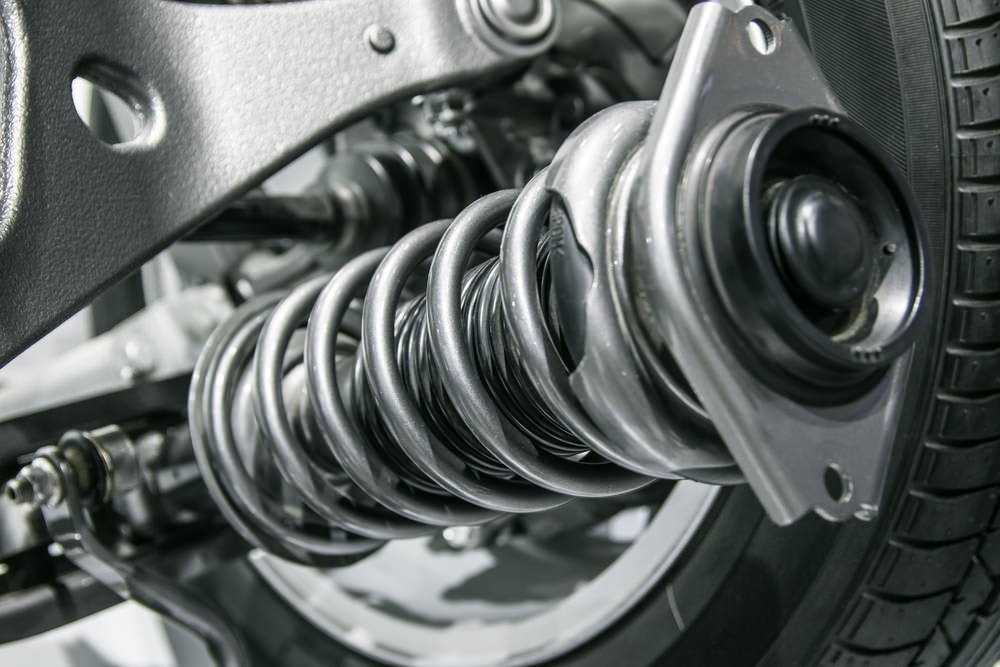

Car aficionados, particularly those involved with racing, sometimes talk about “sprung” and “unsprung” weight (or mass). What do these terms mean?
The spring is the suspension component that holds the vehicle up and cushions it and its occupants and cargo from bumps. A car without springs wouldn’t be very comfortable and would soon fall apart due to shaking and banging. Horse-drawn carts have used springs for centuries, and as far back as the Ford Model T, metal springs were considered standard. Today, every car and truck rides on springs.
But when we say a vehicle “rides on” springs we don’t actually mean the entire vehicle. The portion of any car or truck that is held up by the springs is its sprung weight, and the rest is its unsprung weight.
The difference betweens sprung and unsprung
To understand the difference, imagine a car moving forward until one of its front wheels hits a bump large enough to move that wheel upward toward the body of the car. But as the wheel moves up, the car body might not move much or at all, because it’s isolated from the upward-moving wheel by one or more springs; the springs can compress to allow the body of the car to stay where it is as the wheel moves up and down underneath it. That’s the difference: the body of the car and everything attached solidly to it is sprung, meaning that it’s isolated from the wheels by compressible springs; the tires, wheels, and anything attached directly to them are unsprung, meaning that the springs don’t keep them from having to move when the car comes to a rise or fall in the road.
Almost all of a typical car is sprung weight, because almost every part of it is attached solidly to the body. Besides the body itself that includes all other structural or frame components, the engine and transmission, the interior, and of course the passengers and cargo.
What about unsprung weight? The following are unsprung:
Tires
Wheels
Wheel bearings and hubs (the parts the wheels rotate on)
Brake assemblies (on most cars)
On vehicles with a solid drive axle, sometimes called a live axle, the axle assembly (including the differential) moves with the rear wheels and is therefore unsprung.
That’s not a long list, and particularly for cars with an independent rear suspension (that is, not a solid axle) the unsprung weight represents only a fairly small portion of the total.
Semi-sprung parts
There is one complication: some weight is partly sprung and partly unsprung. Consider for example a shaft that’s attached at one end to the transmission and at the other end to the wheel (a “half shaft”); when the wheel moves up and the body and transmission don’t, one end of the shaft moves and the other doesn’t, so the center of the shaft moves but not as much as the wheel does. Parts like this that have to move when the wheel does, but not as far, are said to be partly sprung, semi-sprung, or hybrid weight. Typical semi-sprung parts include:
- The springs themselves
- Shock absorbers and struts
- Control arms and certain other suspension parts
- Half shafts and some drive shafts
- Certain steering system parts such as the steering knuckle
Why does any of this matter? If a large part of a car’s mass is unsprung, it’s more difficult to keep the tires planted firmly on the road as it rides over bumps because the springs have to apply more force to move them. Having a high ratio of sprung to unsprung weight is therefore always desirable, and is particularly important for vehicles that are intended to handle well at high speeds. Racing teams thus reduce unsprung weight by, for example, using lightweight but delicate magnesium wheels, and engineers try to design suspensions with as little unsprung weight as possible. That’s why a few cars such as the 1961–75 Jaguar E type have employed brakes mounted not to the wheel hub, but to the inboard end of the half shaft: it’s all an effort to reduce unsprung weight.
Note that unsprung weight or mass is sometimes confused with rotating mass because some parts (tires, wheels, most brake discs) fall into both categories and because racers want to reduce them both. But they’re not the same thing. Rotating mass is what it sounds like, anything that has to rotate when the car goes forward, so for example the steering knuckle is unsprung but doesn’t rotate, while the half shaft is rotating but only partly unsprung. Lower unsprung weight improves handling and sometimes traction, while lowering rotating weight improves acceleration.



